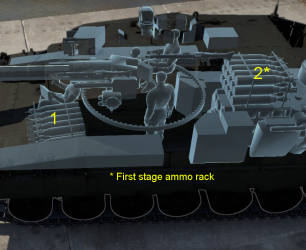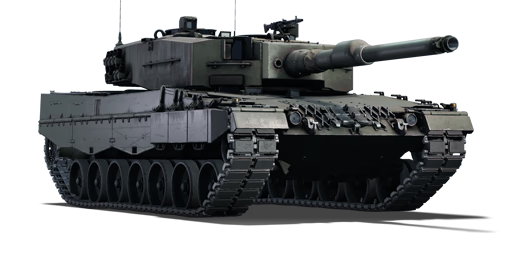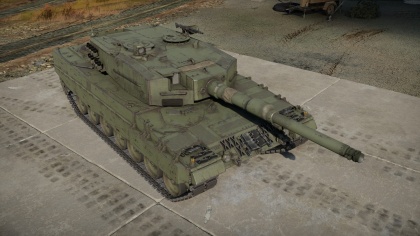Difference between revisions of "Leopard 2A4"
Inceptor57 (talk | contribs) m (Converted Notice template into About template) |
(→See also) |
||
| Line 273: | Line 273: | ||
* ''reference to the series of the vehicles;'' | * ''reference to the series of the vehicles;'' | ||
* ''links to approximate analogues of other nations and research trees.''--> | * ''links to approximate analogues of other nations and research trees.''--> | ||
| − | * [[Leopard 2K]] | + | * [[Leopard 2K]] - Preceding vehicle |
| + | * [[Leopard 2A5]] - Succeeding vehicle | ||
== External links == | == External links == | ||
Revision as of 08:53, 8 July 2019
Contents
| This page is about the medium tank Leopard 2A4. For other uses, see Leopard (Family). |
Description
The Leopard 2A4 is a Rank VII German medium tank
with a battle rating of 10.7 (AB/RB/SB). It was introduced in Update 1.79 "Project X".
General info
Survivability and armour
The armour protection on the Leopard 2A4 can be described as "decent" with the essential areas covered but not much more. While the turret cheeks are well protected against both kinetic (~400mm equivalent, sloped) and chemical (~620mm equivalent, sloped) rounds, the upper frontal plate of the chassis will generally not stop an APDSFS (~150mm equivalent, sloped) round from any of its competitors, but will prevent most chemical rounds from penetrating (~520mm equivalent, sloped). However, the lower front plate is even more vulnerable (280mm equivalent vs HEAT and, 150mm equivalent vs kinetic projectiles, both sloped). Like in the case of its competitors, the turret ring is unprotected and so are the hull sides. While the cannon breech is also lacking in protection, it is not completely absent.
The four crew members are tightly packed with the driver, gunner and commander all forming a line on the starboard side of the tank, making them easy to eliminate in one hit if the Leopard 2A4 is facing the enemy with its hull and turret aligned towards it, thus knocking out the tank. The ammo rack of the tank is positioned in front on the port side, and makes for an easy target. This disadvantage can be easily negated by simply using cover to engage in a hull-down position. There is also a ready-rack at the back of the turret, with blow-out panels to prevent the detonation of the ready-rack from destroying the vehicle (note that FPE must be researched in order for the ammo burnout to be put out).
The armour protection is generally enough if you wish to engage in a long range style of combat as shells will deviate ever so slightly from their predicted path, giving your armour a chance of absorbing them without much damage to be received, though the same can not be said if you wish to engage in fast paced urban combat where shells will land precisely where aimed and enemies will generally attack your sides.
Mobility
| Mobility characteristic | ||
|---|---|---|
| Weight (tons) | Add-on Armour weight (tons) |
Max speed (km/h) |
| 56.0 | N/A | 79 (AB) |
| 72 (RB/SB) | ||
| Engine power (horsepower) | ||
| Mode | Stock | Upgraded |
| Arcade | 2,032 | ____ |
| Realistic/Simulator | 1,327 | ____ |
| Power-to-weight ratio (hp/ton) | ||
| Mode | Stock | Upgraded |
| Arcade | 36.29 | __.__ |
| Realistic/Simulator | 23.70 | __.__ |
Armaments
Main armament
| 120 mm Rheinmetall L44 | |||||
|---|---|---|---|---|---|
| Capacity | Vertical guidance |
Horizontal guidance |
Stabilizer | ||
| 42 | -9°/+20° | ±180° | Two-plane | ||
| Turret rotation speed (°/s) | |||||
| Mode | Stock | Upgraded | Prior + Full crew | Prior + Expert qualif. | Prior + Ace qualif. |
| Arcade | 38.08 | 52.71 | 64.00 | __.__ | 75.29 |
| Realistic | 23.8 | 28.0 | 34.0 | 37.6 | 40.0 |
| Reloading rate (seconds) | |||||
| Stock | Prior + Full crew | Prior + Expert qualif. | Prior + Ace qualif. | ||
| 7.80 | 6.9 | 6.4 | __.__ | ||
Ammunition
| Penetration statistics | |||||||
|---|---|---|---|---|---|---|---|
| Ammunition | Type of warhead |
Penetration in mm @ 0° Angle of Attack | |||||
| 10m | 100m | 500m | 1000m | 1500m | 2000m | ||
| DM12 | HEATFS | 650 | 650 | 650 | 650 | 650 | 650 |
| DM13 | APFSDS | 417 | 414 | 410 | 400 | 395 | 390 |
| DM23 | APFSDS | 410 | 408 | 401 | 393 | 384 | 376 |
| Shell details | ||||||||||
|---|---|---|---|---|---|---|---|---|---|---|
| Ammunition | Type of warhead |
Velocity in m/s |
Projectile Mass in kg |
Fuse delay
in m: |
Fuse sensitivity
in mm: |
Explosive Mass in g (TNT equivalent): |
Normalization At 30° from horizontal: |
Ricochet: | ||
| 0% | 50% | 100% | ||||||||
| DM12 | HEATFS | 1,140 | 13.5 | 0.0 | 0.1 | 1,640 | +0° | 65° | 72° | 75° |
| DM13 | APFSDS | 1650 | 4.44 | N/A | N/A | N/A | +1.5° | 76° | 77° | 78° |
| DM23 | APFSDS | 1640 | 4.3 | N/A | N/A | N/A | +1.5° | 78° | 80° | 81° |
Ammo racks

| Full ammo |
1st rack empty |
2nd rack empty |
Visual discrepancy |
|---|---|---|---|
| 42 | 16 (+26) | 1 (+41) | no |
1st rack empty: 16 (+26)
2nd rack has blowout panels
Machine guns
| 7.62 mm MG 3A1 | ||||||
|---|---|---|---|---|---|---|
| Pintle mount | ||||||
| Capacity (Belt capacity) | Fire rate (shots/minute) |
Vertical guidance |
Horizontal guidance | |||
| 2,000 (1,000) | 1,200 | -8°/+20° | ±120° | |||
| Coaxial mount | ||||||
| Capacity (Belt capacity) | Fire rate (shots/minute) |
Vertical guidance |
Horizontal guidance | |||
| 4,500 (1,000) | 1,200 | N/A | N/A | |||
Usage in battles
When stock, the HEATFS round will help you pick enemies from a distance, thus avoiding taking damage as you will have no Parts nor FPE, but will not be enough against some tanks like the M1 Abrams and the T-80B; T-64B when these tanks are equipped with add-on ERA. This becomes less of a problem once you have unlocked kinetic shells.
The vehicle, like most of its own league, can be played as a sniper tank due to its excellent optics, or in an urban environment thanks to its powerful engine, high top speed and acceleration and potent top shell which allows quick, but deadly snapshots.
Notable enemies are, on one hand, the IPM1 and M1 Abrams which are almost completely immune to your stock HEAT round, but have a weak turret ring and the Russian MBTs which can equip add-on armor in order to negate the effects of an initial HEAT shell, subsequent penetration is generally possible after the ERA blocks have been detonated; ERA blocks are negated by the use of APDSFS ammunition, notably the DM23 vs T-80B while the DM13 will be enough for all of the others, given a chassis hit.
Modules
| Tier | Mobility | Protection | Firepower |
|---|---|---|---|
| I | Tracks | Parts | Horizontal drive, DM13 |
| II | Suspension, Brake System | FPE | Adjustment of Fire |
| III | Filters | Crew replenishment | Elevation mechanism, Smoke grenade |
| IV | Transmission, Engine | Artillery support, DM23, Laser rangefinder |
Pros and cons
Pros:
- Powerful engine, high top speed and acceleration
- High scope magnification for long range operations
- Potent selection of ammunition
- Effective turret armour
Cons:
- Hull armour leaves much to be desired
- Can be easily ammo racked
- Difficult stock grind
- Next to no anti-air capability, can not reliably eliminate attacking helicopters except with the 120 mm cannon
History
Based on the testing results gathered from the various different Leopard 2K prototypes, a new Leopard 2 prototype was constructed that would be more representative of the final version of the vehicle. Designated as Leopard 2AV, the new prototype featured a redesigned hull and turret over the Leopard 2K. Furthermore, the prototype was tested with two different cannons; the British L7 105mm rifled and the German Rheinmetall 120mm smoothbore cannon.
In 1976, the Leopard 2AV was sent overseas to the United States to be comparatively tested against the new American state-of-the-art XM1 Abrams. During testing, the Leopard 2AV proved itself as a good counterpart to the Abrams, outperforming its competitor in terms of fire accuracy, whilst demonstrating somewhat inferior protection and gun handling. Upon arriving back to its homeland with positive testing results, the decision was made to begin mass production of the Leopard 2 in 1977.
The production version Leopard 2, however, differed from the AV prototype in receiving an increased level of protection before mass production began. Mass production of the Leopard 2 started in 1979 with the Leopard 2A0 forming the first batch that would enter service with the German Bundeswehr in late 1980.
Throughout the production period of the early Leopard 2 versions, modernization and upgrades were being applied on the assembly line in order to keep the newest Leopards up to the latest standards. These modernization efforts mostly involved the upgrading of internal modules such as the aiming and communications systems. As a result of this, all early Leopard 2s (A0-A4) were visually neigh identical to each other. The Leopard 2A4 was the final early Leopard 2 variant before the more advanced and heavily upgraded subsequent Leopard 2 versions made their appearance as part of a new wave of modernization efforts.
A total of 695 Leopard 2A4s were built out of the total of 2.125 early Leopard 2s that were manufactured between 1979 - 1991. The Leopard 2 and its variants served primarily with the German Bundeswehr, but a number of export vehicles were sold to nations world-wide, ranging from Canada and Chile, over Denmark and Austria to Greece and Turkey to name a few.
-From Devblog
Media
-By NUSensei
See also
- Leopard 2K - Preceding vehicle
- Leopard 2A5 - Succeeding vehicle
External links
| Germany medium tanks | |
|---|---|
| Pz.III | Pz.III B · Pz.III E · Pz.III F · Pz.III J · Pz.III J1 · Pz.III J1 TD · Pz.III L · Pz.III M · Pz.III N |
| Pz.IV | Pz.IV C · Pz.IV E · Pz.IV F1 · Pz.IV F2 · Pz.IV G · Pz.IV H · Pz.IV J · Pz.Bef.Wg.IV J |
| Pz.V | VK 3002 (M) · Panther A · Panther D · Panther F · Panther G · Ersatz M10 · Panther II |
| M48 upgrades | M48A2 G A2 · M48 Super |
| Leopard 1 | Leopard I · Leopard A1A1 · Leopard A1A1 (L/44) · Leopard 1A5 · C2A1 · Turm III |
| Leopard 2 | PT-16/T14 mod. · Leopard 2K · Leopard 2AV |
| Leopard 2A4 · Leopard 2 (PzBtl 123) · Leopard 2A4M · Leopard 2 PL · Leopard 2A5 · Leopard 2 PSO · Leopard 2A6 · Leopard 2A7V | |
| Trophies | ▀M4 748 (a) · ▀T 34 747 (r) |
| Other | Nb.Fz. · KPz-70 |
| USA | mKPz M47 G · M48A2 C |
| USSR | ◊T-72M1 |





